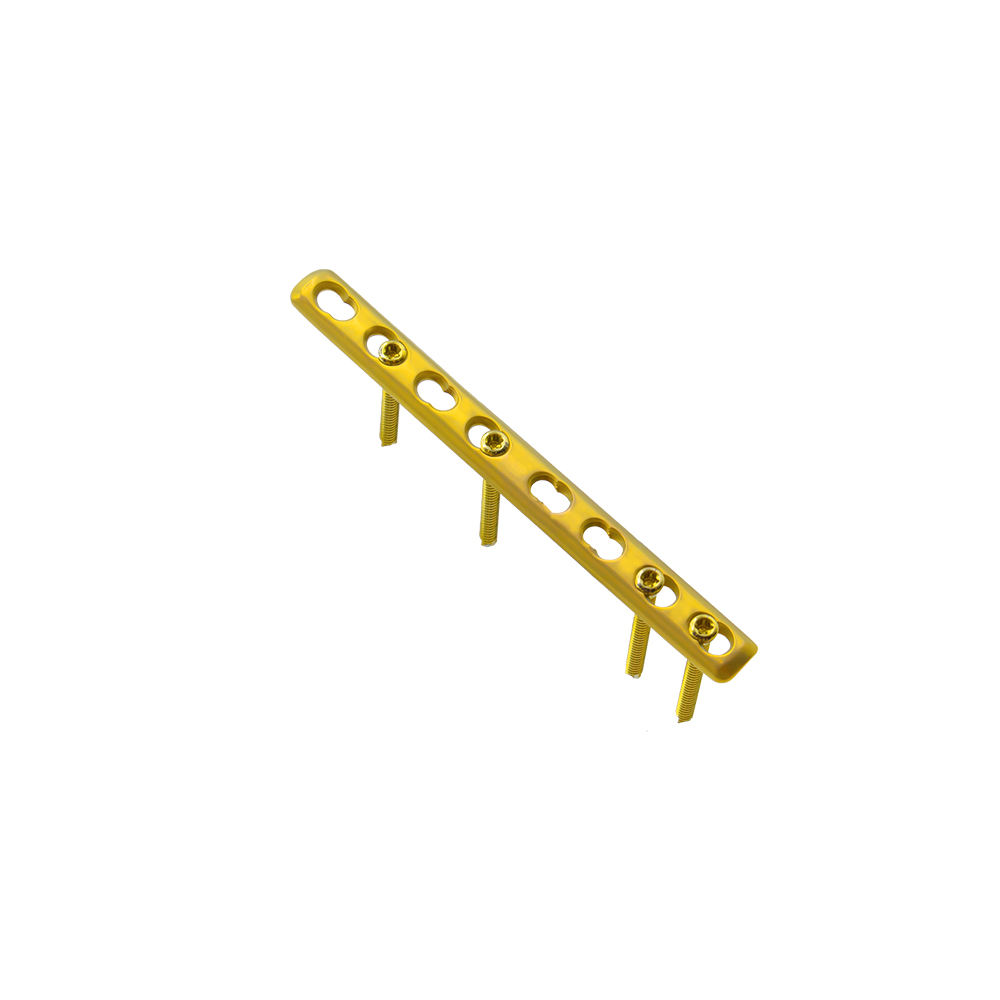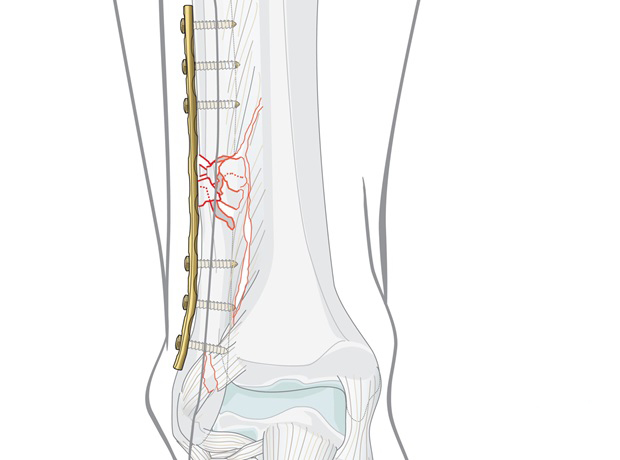Fractures can significantly impact a person's life, causing pain, immobility, and reduced quality of life. Over the years, medical technology has evolved to provide better treatment options for fractures, and one such innovation is the 1/3 tubular locking plate. This article will delve into the details of this revolutionary medical device, its applications, advantages, surgical technique, and more.
Traditional methods of fracture fixation often involved the use of plates and screws to stabilize the fractured bone. While effective, these traditional implants had limitations, such as the risk of screw loosening and implant failure. The introduction of locking plates revolutionized fracture management by addressing these concerns and providing improved stability.
What is a 1/3 Tubular Locking Plate?
The 1/3 tubular locking plate is a type of locking plate used in orthopedic surgery. It is named "1/3" due to its design, which covers one-third of the bone's circumference. The plate is made of high-quality medical-grade stainless steel or titanium, making it strong and biocompatible. Its tubular structure enhances its strength while allowing for reduced contact with the bone, minimizing the risk of infection and interference with blood supply.


Use in Fracture Management
The 1/3 tubular locking plate is a versatile implant that finds application in the treatment of various fractures. It is commonly used in long bone fractures, such as those in the femur, tibia, and humerus. The plate's design allows for stable fixation, facilitating bone healing and promoting early mobilization.
Stability and Load Distribution
The locking mechanism of the plate provides excellent stability compared to traditional plates and screws. It creates a fixed-angle construct that prevents screw back-out and ensures a rigid fixation, reducing the risk of malalignment and non-union. The load-sharing properties of the plate also contribute to even distribution of forces during weight-bearing, reducing stress on the healing bone.
Minimally Invasive Surgery
The 1/3 tubular locking plate supports the concept of minimally invasive surgery, where smaller incisions are made, leading to faster recovery, reduced scarring, and less soft tissue damage. This is particularly beneficial for elderly or osteoporotic patients who may have delicate bone structures.
Surgical Technique and Implantation Process
The successful outcome of any surgery depends on meticulous planning and precise execution. The implantation of a 1/3 tubular locking plate follows a systematic surgical technique:
Preoperative Planning
Before the surgery, the orthopedic surgeon conducts a detailed evaluation of the fracture using X-rays or CT scans. This helps in selecting the appropriate plate size and screw positions for optimal fixation.
Incision and Exposure
During the surgery, the surgeon makes a small incision over the fractured bone and carefully exposes the fracture site to visualize the broken fragments.
Plate Selection and Placement
The correctly sized 1/3 tubular locking plate is chosen, and it is contoured to match the bone's shape. The plate is then fixed to the bone using locking screws, which are inserted into the bone through predefined holes in the plate.
Screw Insertion
Locking screws are carefully inserted into the bone through the plate, creating a stable construct. The locking mechanism prevents the screws from loosening, providing a secure fixation.
Wound Closure
Once the plate and screws are in place, the incision is closed using sutures, and the surgical site is dressed.

Postoperative Care and Rehabilitation
Following the surgery, postoperative care is essential to ensure proper healing and recovery. Patients are provided with pain management medication and are encouraged to begin physical therapy to regain strength and mobility.
Comparison with Traditional Plates and Screws
The 1/3 tubular locking plate offers several advantages over traditional plates and screws. The locking mechanism reduces the risk of screw loosening and back-out, leading to more stable fixation and improved fracture healing rates. Additionally, the reduced implant-to-bone contact lowers the chances of infection and interference with blood supply.
Potential Complications and Risk Mitigation
As with any surgical procedure, the use of 1/3 tubular locking plates carries certain risks, including infection, implant failure, and non-union. However, with careful patient selection, meticulous surgical technique, and postoperative care, these risks can be significantly minimized.
Success Stories and Case Studies
Numerous success stories and case studies demonstrate the efficacy of 1/3 tubular locking plates in fracture management. Patients have reported faster recovery times, reduced pain, and improved quality of life following the use of these innovative implants.
Future Innovations and Research in Locking Plates
The field of orthopedic surgery is continually evolving, and ongoing research is focused on further improving locking plate technology. Future innovations may include biodegradable materials, advanced locking mechanisms, and patient-specific implants tailored through 3D printing technology.
Conclusion
In conclusion, the 1/3 tubular locking plate represents a significant advancement in fracture management. Its unique design, stability, and load-sharing properties make it a valuable tool for orthopedic surgeons in treating various fractures. As research and technology progress, we can expect even more remarkable developments in the field of orthopedic implants.
FAQs
Q: How long does the surgery to implant a 1/3 tubular locking plate typically take?
A: The surgery duration can vary depending on the complexity of the fracture, but it generally takes a few hours.
Q: Is the 1/3 tubular locking plate suitable for pediatric fractures?
A: The use of locking plates in pediatric patients is subject to the surgeon's discretion and the specific case. Pediatric plates may be more appropriate in certain situations.
Q: Are there any dietary restrictions after the surgery?
A: Your orthopedic surgeon or healthcare provider will provide specific postoperative instructions, which may include dietary guidelines for optimal healing.
Q: How soon can I return to regular activities after the surgery?
A: The recovery time varies from patient to patient, but many individuals can begin resuming regular activities within a few weeks to months post-surgery.
Q: What is the success rate of 1/3 tubular locking plate surgeries?A: The success rate is generally high, and most patients experience significant improvement in their condition after the surgery.
How to Buy Orthopaedic Implants and Orthopaedic Instruments?
For CZMEDITECH, we have a very complete product line of orthopedic surgery implants and corresponding instruments, the products including spine implants, intramedullary nails, trauma plate, locking plate, cranial-maxillofacial, prosthesis, power tools, external fixators, arthroscopy, veterinary care and their supporting instrument sets.
In addition, we are committed to continuously developing new products and expanding product lines, so as to meet the surgical needs of more doctors and patients, and also make our company more competitive in the whole global orthopedic implants and instruments industry.
We export worldwide, so you can contact us at email address song@orthopedic-china.com for a free quote, or send a message on WhatsApp for a quick response +86-18112515727.
If want to know more information,click CZMEDITECH to find more details.
English
Français
Русский
Español
العربية
Português
Deutsch
italiano
日本語
한국어
Nederlands
Tiếng Việt
ไทย
Polski
Türkçe
አማርኛ
ພາສາລາວ
ភាសាខ្មែរ
Bahasa Melayu
ဗမာစာ
தமிழ்
Filipino
Bahasa Indonesia
magyar
Română
Čeština
Монгол
қазақ
Српски
हिन्दी
فارسی
Kiswahili
Slovenčina
Slovenščina
Norsk
Svenska
українська
Ελληνικά
Suomi
Հայերեն
עברית
Latine
Dansk
اردو
Shqip
বাংলা
Hrvatski
Afrikaans
Gaeilge
Eesti keel
Māori
नेपाली
Oʻzbekcha
latviešu
অসমীয়া
Aymara
Azərbaycan dili
Bamanankan
Euskara
Беларуская мова
भोजपुरी
Bosanski
Български
Català
Cebuano
Corsu
ދިވެހި
डोग्रिड ने दी
Esperanto
Eʋegbe
Frysk
Galego
ქართული
guarani
ગુજરાતી
Kreyòl ayisyen
Hausa
ʻŌlelo Hawaiʻi
Hmoob
íslenska
Igbo
Ilocano
Basa Jawa
ಕನ್ನಡ
Kinyarwanda
गोंगेन हें नांव
Krio we dɛn kɔl Krio
Kurdî
Kurdî
Кыргызча
Lingala
Lietuvių
Oluganda
Lëtzebuergesch
Македонски
मैथिली
Malagasy
മലയാളം
Malti
मराठी
ꯃꯦꯇꯥꯏ (ꯃꯅꯤꯄꯨꯔꯤ) ꯴.
Mizo tawng
Chichewa
ଓଡ଼ିଆ
Afaan Oromoo
پښتو
ਪੰਜਾਬੀ
Runasimi
Gagana Samoa
संस्कृत
Gaelo Albannach
Sepeti
Sesotho
chiShona
سنڌي
Soomaali
Basa Sunda
Wikang Tagalog
Тоҷикӣ
Татарча
తెలుగు
ትግንያውያን
Xitsonga
Türkmençe
संस्कृत
ئۇيغۇرچە
Cymraeg
isiXhosa
ייִדיש
Yorùbá
isiZulu













